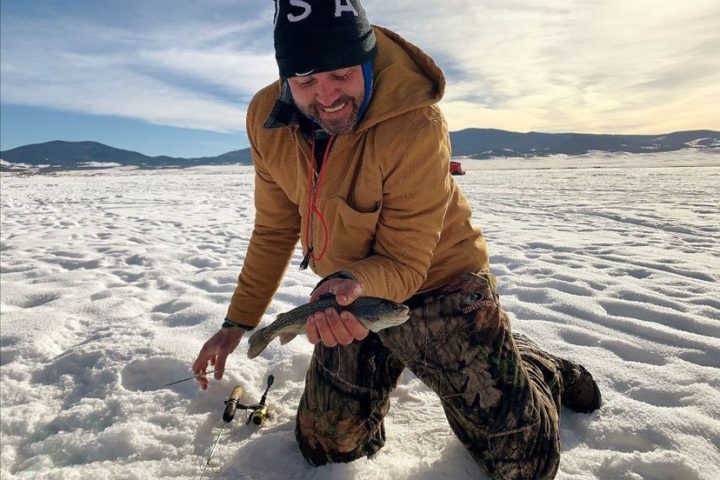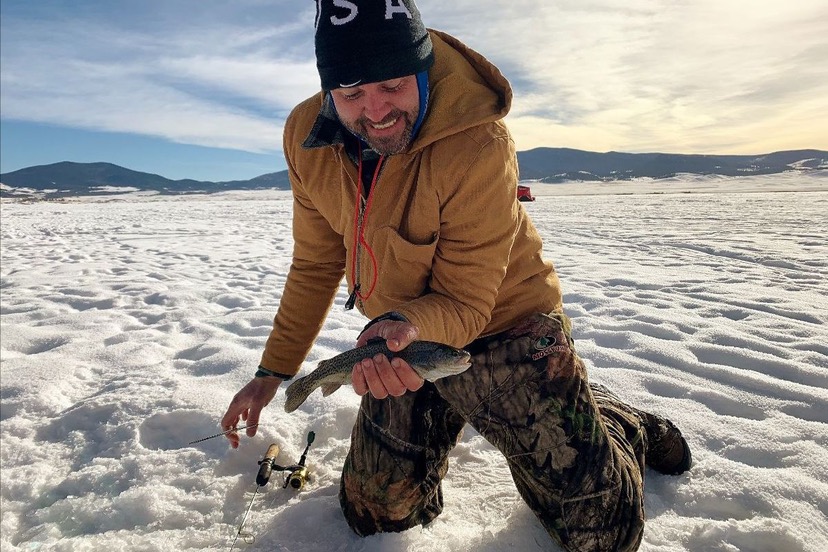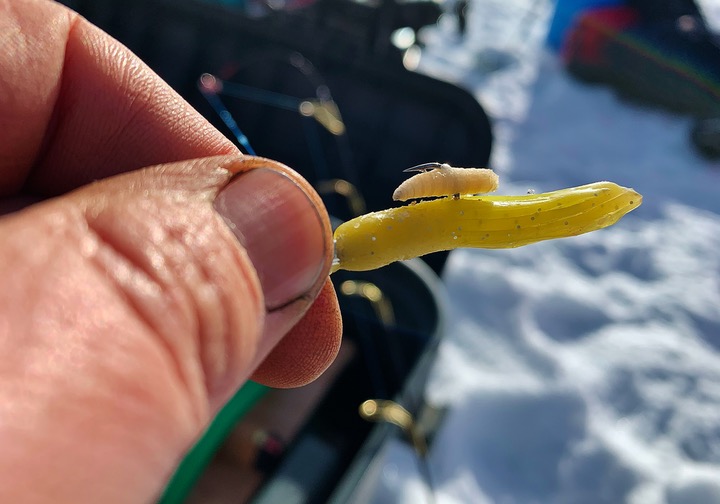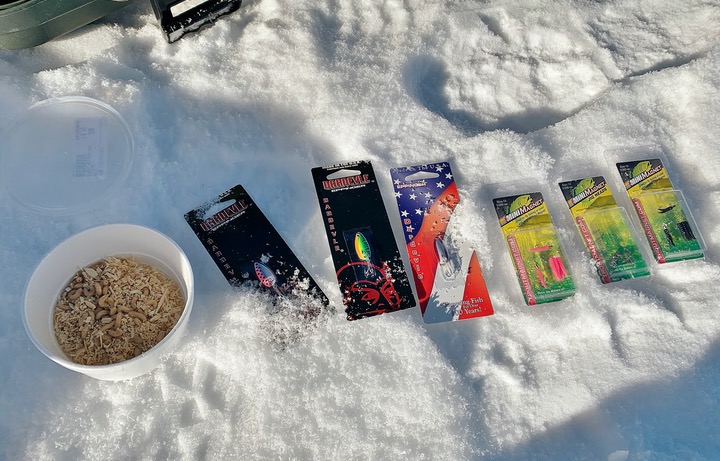As we continue to confront the demand for social distancing amid the global pandemic, I’m convinced there is no better outdoor winter activity than ice fishing.
As I learned last winter, ice fishing is one of the most solitary sports you can engage in, as you venture out on an ice-covered reservoir, drill a hole, drop your lure and sit in your hut waiting for action.
It’s the perfect COVID-19 sport. Maybe that’s why more and more folks are taking up ice fishing. And I certainly noticed more huts out on the ice when I visited the Colorado ice fishing mecca of Eleven Mile State Park recently to get some tips from some CPW staff members for getting into this growing sport.
“There’s been more and more people taking it up,” said Mount Shavano Hatchery Manager Bryan Johnson, who was at the park stocking 20,000 cutbows (cutthroat/rainbow trout hybrids) on January 12.
Johnson, also a master angler, said the crew from the Mount Shavano Hatchery stock around 100,000 cutbows and 15,000 Snake River cutthroats every winter and anywhere between 100,000 to 500,000 two-inch kokanee salmon in the spring.
“That’s one thing I’ve noticed, everywhere I’ve gone in the state, is that there’s so many people ice fishing now, because it’s so simple,” he said. “You don’t need a $40,000 boat. You just need an auger, whether it’s a hand auger or a power auger. It’s nice to have an ice hut, but you don’t necessarily have to have one. You just need a bucket, a rod, and an auger and you’re good to go.”
I’ve heard it’s even possible to go ice fishing with a normal-sized fishing rod, although now that I’ve been ice fishing, I can see why it’s beneficial to have the shorter pole you can set up by your hole.
It was a brisk Tuesday morning at 20 degrees below zero when I arrived at the park. CPW’s Northeast Region Public Information Officer Jason Clay and I hand drilled our first four-inch holes near the boat ramp on Eleven Mile’s north shore.

It wasn’t nearly as hard as I thought it would be, although if you were making lots of holes throughout the day, I could see how it could easily become a shoulder workout.
After setting up the ice huts that Northeast Region Hunter Outreach Coordinator Pepper Canterbury graciously brought along for the day, I talked to her to get some tips for beginners. I asked her what newbies like me should know about ice fishing.
“The number one thing is safety,” she said. “Know your ice. And two, you can do it without a lot of money. It’s a sport where you can get out and you don’t have to have a lot of expensive equipment. And you don’t have to be out all day. It doesn’t have to be something that’s a daunting event.”
So how exactly do you know your ice?
“You want at least five inches of nice, clear solid ice,” she said. “You don’t want to be on anything less than five inches. If you can’t see through it, then there’s a lot of air pockets in there and it’s rotten.
“You can take a hatchet or an ax as you’re walking, if it’s in the springtime or beginning of the season, and people will hit the ice on their way out to test the thickness and the solidity of it. If you’re fishing in the spring or the early, early season, you need to be really careful.”
At Eleven Mile, you’re typically safe from January through the beginning of March. But as Johnson told me, no ice is completely safe.
“I went swimming a couple of years ago and it’s not fun,” he said. “There was 14 inches on the entire lake, and I found a spot that had a half inch.”
CPW’s website has good tips for ice fishing safety, including things like bringing ice cleats and easily accessible ice picks that can help you pull your way back onto the ice if you fall in. I also learned that if you’re going fishing with a group, you should walk single file when venturing out onto ice for the first time and drill test holes as you go.
So you’ve drilled your hole and you’ve got your rod. What bait works best?
“Pink and white are two colors that typically do really well out here (at Eleven Mile State Park),” Johnson said. “Look for a one- to two-inch tube jig or a trout magnet or some kind of other little plastic bait like that. And then tip it with half a mealworm or a waxworm.”
Johnson said where and how you fish depend on your goals. If you’re looking for really big fish, a dead stick out in 10-20 feet of water might be a good tactic. If you’re out with your kids and looking to catch a lot of little fish, aggressive jigging in shallow water might be your best bet.
“The thing about stock trout is, remember they’re freshly stocked and they’re a lot easier to catch, so aggressive jigging works well,” Johnson said. “You don’t necessarily need a dead stick. And a lot of times they’ll even avoid a dead stick for whatever reason. You could just let your bait sit there and the second you start moving it, you’ll have whole schools in there trying to eat it.”
And what about the elusive and delicious kokanee salmon?
For kokanee, Johnson says you need to get out over deep water and your efforts will be greatly aided by a fish finder. As for trout, “You can catch trout anywhere,” he said. “You can fish five feet under the ice over 80 feet of water. The trout just spread out everywhere in here because there’s so much food.”
Despite all the great tips Clay and I received, we didn’t have much luck catching fish until after Johnson had finished stocking. It was getting near 4 p.m. and with chilly toes, I was about ready to call it a day, but we decided to give it a little more time with some aggressive jigging.
Sure enough, just as the sun was beginning to inch close to the horizon, we both caught a few of the stocked cutbows with some aggressive jigging. As we pulled our fish through the 24-inch-thick ice, we remembered the advice CPW Aquatic biologist Tyler Swarr had given us earlier in the day about handling fish.
“Proper handling through the ice is important,” Swarr said, “especially when it’s this cold, because their gills will freeze within a few seconds. People will take pictures, but within a few seconds of being in negative 20 degree weather, those gills are going to freeze and that fish is toast.
Also, you’ve got to keep them wet. You always want to have wet hands before you touch the fish. If you have dry hands or if you rub against your coat or gloves, it’ll rub their slime coat off. It’s a big part of their immune system, it helps them get around, and it helps protect them.”
For our grip-and-grin photos, Clay and I kept the head of the fish in the water as long as we could and counted down from three to get a quick photo before releasing the fish back into the reservoir.
“By next winter those 10-inchers we stocked today will be 16 to 18 inches,” Johnson said. “The winter after that they’re 22 to 24 inches. After that, they’re like eight to 12 pounds. They’re huge fish and they grow super fast out here. This is one of the best lakes in the state, especially for quality big fish.”
Advice from Master Angler Bryan Johnson on other places to ice fish in Colorado:
Lake John
I just came back from Lake John. I fished up there this past weekend. That place is awesome right now for huge fish. They had a tournament up there and the top five fish were over 26 inches long. All the fish were 8 to 10 pounds that were in the top five in that tournament. It’s got cutbows, rainbow trout and Snake River cutthroats, but it’s prime right now for big fish.
North Delaney Butte Lake and South Delaney Butte Lake
The Delaney’s up by Walden fish really well. North Delaney is where we take the brown trout spawn. So it has browns, but it also has cutbows in it. Then the South Delaney has cutbows, browns, and snake river cutthroats and it fishes pretty well.
Wolford Mountain Reservoir
Just for lakes to go to catch lots of fish, you’ve got Wolford up by Kremmling. I take my kids up there every year, they love it. We catch a ton of fish. You don’t get very big fish but you can catch a bunch of fish.
Frantz Lake
In Salida, where the hatchery is, we have Frantz Lake. It’s heavily stocked with catchables and the ice fishing is just non-stop action all winter long.
Lake Granby and Blue Mesa Reservoir
These are places in the state that have a big following for lake trout. You can target little lake trout or you can target fish up to 30 pounds in some of those places. Typically people fish at 30 to 80 feet for those in the wintertime, but you can catch them up shallow too.



